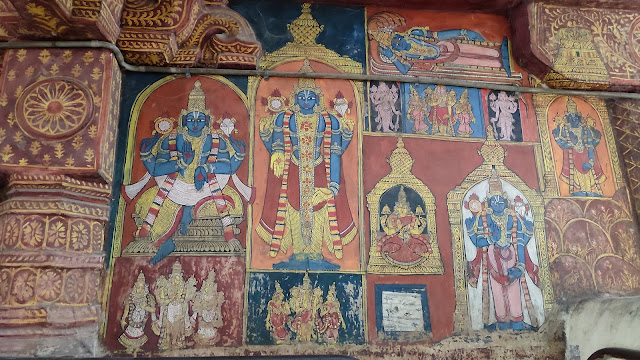Isn’t it so amazing that for a temple town with over a thousand temples, there is only one to a feminine deity? Just the one for the lady Kamakshi, who reigns over the kshetra.
On our ‘extra day’ at Kanchipuram, there was a long list of things to do. The Lord Varadaraja Perumal was first order of business.
This is a stunning temple complex with some highly intricate sculpture.
A busload of tourists had arrived and that lengthened the queue time, during which I was able to admire the peeling but still wonderful paintings that covered the walls.
We went to see the gold and silver lizards, where there was quite a bit of silly shoving not to mention yelling by the guards. I admit I felt a pang of worry with COVID so recently past, to touch them but it didn’t feel right to not do the done thing, either.
In the main sanctum, the Lord himself was utterly magnificent. The temple has a long history (apparently has around 350 inscriptions from various dynasties) and is one of the 108 divya desams of Vishnu.
Next we asked Raj, our driver, to find us a way to the river. He consulted a local or two, followed a track with some dust raised on it and delivered us, quite without volition, at the Shri Kanchi Kamakoti Peetam. Now this is hallowed ground – the Peetam or Seat was established by Adi Shankara and has an unbroken lineage of 70 acharyas. We must’ve heard that phrase any number of times in our lives. However, somehow, it was not on our ‘Plan A’ checklist. But here we were, and since we were there, we went in. Only to stumble upon grand jayanti celebrations marking the birthday of the Jagadguru Bala Periyava that were underway with all the luminaries of the Peetam on stage. A little abashed, we occupied seats and sat for a while before crouching out in what we hoped was an unobtrusive manner.
We visited the brown riverbed that passes for River Vegavati, once again dismayed at the state of southern rivers.
+++
That evening we made our way to the Kailashanathar koil. Words fail me as I try to describe the beauty of this wonderful Pallava-era structure. Built with sandstone, this is a square layout of exceptional beauty and balance.
The lingam is a large and faceted one; I think they said 16, but I cannot be sure. We met an irascible, venerable old man here, one of the priests of the shrine. We fell to talking and he shared a little of what it was like to continue in work that was under appreciated today, brought in far too little… but we could see that he could not imagine his life in any other way but in the service of Shiva.
Around the main shrine, built cunningly into the structure, is a narrow circumambulatory passage. You are required to crouch into the tunnel which encircles the linga, and emerge onto Shiva’s left, a pradakshina that is said to give moksha to those who complete it. A young man before us attempted to clamber up with his backpack still strapped on. “Idé eDu!” our elderly priest chided him. “Remove this! Put it down here! No one is interested in your bag.” It was symbolic. You must drop your baggage if you set off on the path to mukti.
It reminds me of Kabir:
कबीर का घर सिखर पर जहाँ सिलहली गेलपाऊँ का टिके पिपील का तहाँ खलकन लादे बैल
On the very peak is Kabir’s home, and every step is treacherous
Even the ant finds the path slippery, how then to take a bullock-cart up?
We sat a while in the dusk, looking at the lovely lines of the temple. It is maintained by the Archaeological Survey of India, with the typical landscaping they deem appropriate for every single site under their domain – lawns dotted with the occasional shrub. But they permit prayers in here, while preserving the structure, so I will not carp too much about that.
We then visited the dargah of Hazrat Syed Shah Hameed Auliya of the Qadri, Chishti order, where we sat awhile.
Then wandered over to Vaikunda Perumal koil, an atmospheric and very charming temple.
Alas, although it was down the street from our hotel, we could not visit the Chitragupar koil. Said to be an assistant of Yama’s, this gent is responsible for the accounts of our destiny, entries of our good and bad deeds. It is a rare temple and I should have liked to have seen it: Chitragupta, by logic, is a good deity to have in your corner. It was not to be. In any case, it would have been academic. I have turned over all my accounts books to someone else. He will fudge them for me.












